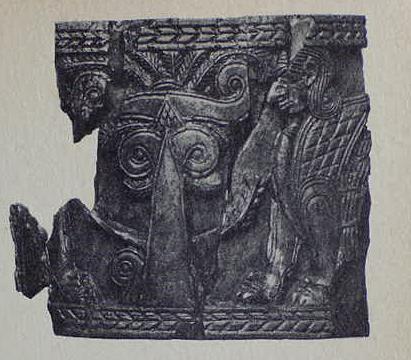The "Tree of Life" in the Garden of Eden may be the below Syrian composite of the Phoenician Lotus and Papyrus tree, a re-interpretation of Egyptian Solar iconography associated with the resurrection of the dead to life from the great Lotus blossom that gives birth each day to the Sun-god and gods of Egypt, assuring them immortality, fused with the sacred Mesopotamian Date Palm. Note the PALM BRANCHES above the tree's trunk. Solomon's Temple was decorated with Cherubim and Palm Trees (1 Kings 6:29, 32).
Below, a Sacred Tree with Palm branches, a fusion of North Syrian art with Phoenician Lotus/Papyrus blossoming sacred trees. The tree is flanked by two winged Sphinxes, Hebrew Cherubim, possessing human heads, lion bodies and wings. This is an ivory prixis or circular box ca. the 8th century BCE, found at Nimrud, ancient Calah (cf. p. 75. fig. 80. William Culican. The First Merchant Venturers, The Ancient Levant in History and Commerce. London. Thames & Hudson. 1966)
Below, a closeup of a "Proto-Aeolic" volute capital from Hazor, like others used in Israelite royal architecture, was derived from the Sacred Palm design, as seen on the above prixis found at Nimrud (cf. p.75. fig. 79. William Culican. The First Merchant Venturers, The Ancient Levant in History and Commerce. London. Thames & Hudson. 1966)
Culican on Israelite and Judaean royal sculpture employing Phoenician designs of the Sacred Tree :
"In recent excavations on Ophel, Miss Kenyon unearthed dressed blocks and a pillar capital of proto-Aeolic form, elsewhere associated with 'royal architecture'. Possibly this was part of the Solomonic retaining wall of the Millo.
Following the division of Solomon's territories into two kingdoms, it was the northern kingdom of Israel which maintained closest contact with Phoenicia...The capital built by Omri at Samaria (the only major town founded by the Israelites) continued the Solomonic tradition in architecture and featured proto-Aeolic capitals with two curling lotus volutes. Similar capitals, ancestral to the Greek Ionic order, have been found in stratum IV at Megiddo, at Hazor, and in Cyprus. The tradition was continued in Judah (the southern kingdom), where the palace probably built by King Uzziah at Ramat Rahel is a minor work of royal style." (pp. 75-76. Culican)
